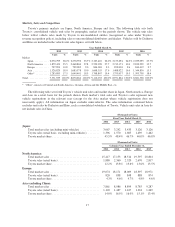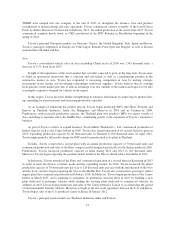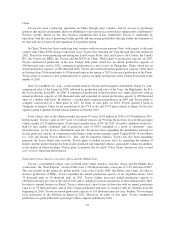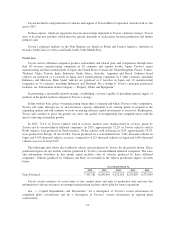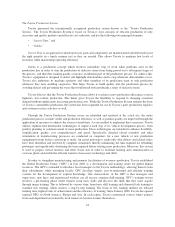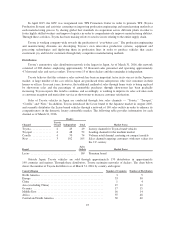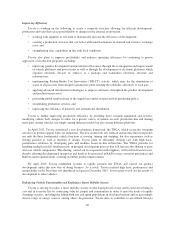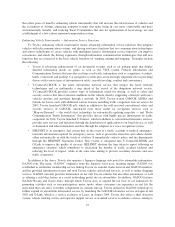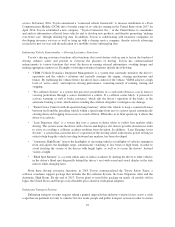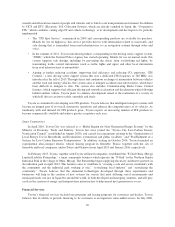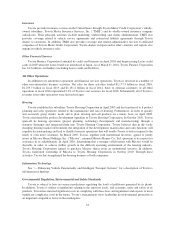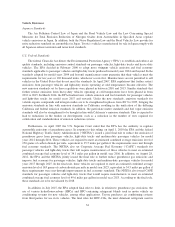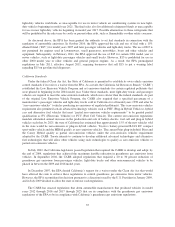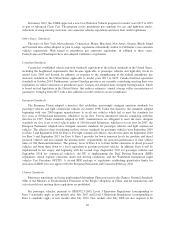Toyota 2015 Annual Report Download - page 32
Download and view the complete annual report
Please find page 32 of the 2015 Toyota annual report below. You can navigate through the pages in the report by either clicking on the pages listed below, or by using the keyword search tool below to find specific information within the annual report.that offers peace of mind by enhancing vehicle functionality that will increase the attractiveness of vehicles and
the excitement of driving, enhancing transport systems that make being in cars more comfortable and more
environmentally friendly, and realizing Smart Communities that aim for optimization of local energy use and
establishment of a low-carbon emission transportation system.
Enhancing Vehicle Functionality — Information Service Functions
To Toyota, enhancing vehicle functionality means advancing information service functions that integrate
vehicles with telecommunication systems, and driving assistance functions that use communication technologies
and sensor technologies to create vehicles with intelligent features. Information service functions can improve
convenience and enrich the driving experience through information communication technologies that add new
functions that are connected to the basic vehicle functions of “running, turning and stopping.” Examples include
the following:
• Toyota is advancing enhancement of car navigation systems, such as car parking maps that display
detailed information inside car parks, as well as the VICS system (Vehicle Information and
Communication System) that provides real-time road traffic information such as congestion, accidents,
traffic restrictions and parking. Car navigation systems play an increasingly important role in providing
drivers with various types of information on safety, smooth traveling, comfort and convenience.
• T-Connect/G-BOOK is the latest information network service that merges the latest network
technologies and car multimedia a step ahead of the arrival of the ubiquitous network society.
T-Connect/G-BOOK provides various types of information useful for driving, as well as safety and
security services that detect unusual conditions in the vehicle, thereby supporting a lifestyle with one’s
vehicles anytime and anywhere through a network. In 2005, Toyota started G-BOOK ALPHA and
G-Link for Lexus, each with additional various features including traffic congestion forecast service. In
2007, Toyota launched G-BOOK mX, which in addition to the well-received conventional safety and
security services of G-BOOK, introduced even more useful car navigation services such as
“Map-on-Demand” — the world’s first technology for automatically updating map data — and “Probe
Communication Traffic Information” that provides drivers with highly precise information on traffic
congestion. In 2014, Toyota launched T-Connect, which in addition to conventional telematics services,
provides new services and functions through the distribution of applications to on-board device, as well
as destination and other information searches through the adoption of a voice recognition system.
• HELPNET is an emergency dial system that, in the event of a traffic accident or medical emergency,
transmits information required for emergency rescue, such as present-location data and vehicle details,
either automatically or with the touch of a button. It immediately contacts police and fire departments
through the HELPNET Operation Center. This system is integrated into T-Connect/G-BOOK and
G-Link to improve the quality of services. HELPNET shortens the time taken to report following an
emergency situation, which contributes to decreasing the number of traffic accident fatalities and
reducing the level of impact, while at the same time aiming to prevent secondary disasters and ease
traffic congestion.
In addition to the above, Toyota also operates a Japanese-language web portal for automobile information,
GAZOO.com. The name “GAZOO” originates from the Japanese word gazo, meaning images. GAZOO was
established as an Internet membership service linking Toyota, its national dealer network and GAZOO members,
and has provided information on new and used Toyota vehicles and related services, as well as online shopping
services. GAZOO currently provides information on not only Toyota vehicles but also other automakers, as well
as offering a rich blog feature as a social networking portal site on automobiles. In addition, GAZOO features
GAZOO Racing and Gazoo mura, through which Toyota aims to expand the fan base of car enthusiasts by
promoting activities such as user-participatory motor sports, where customers can experience in real life the
enjoyment that cars offer, to further complement its contents line-up. Toyota utilized its GAZOO technology to
further expand its automobile information service by launching the G-BOOK telematics service in Japan in fall
2002 and G-Link, which is a service exclusive to Lexus, in August 2005. Toyota also offers a theft detection
system, vehicle tracking service and operator support service as standard services to enhance services aiming to
27


